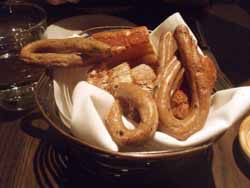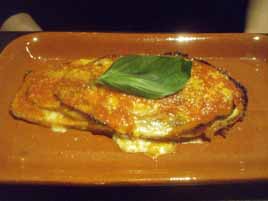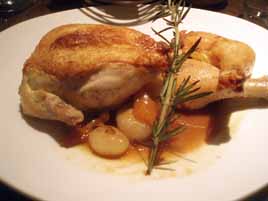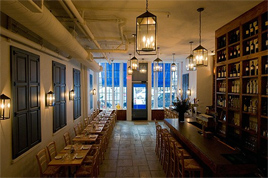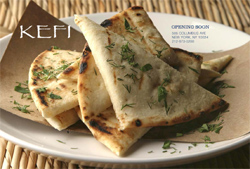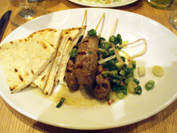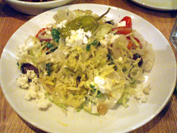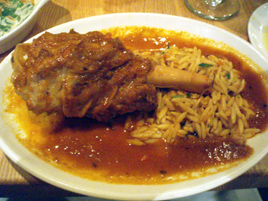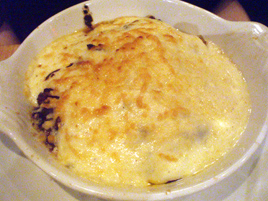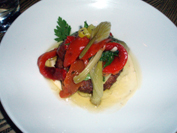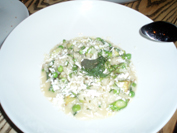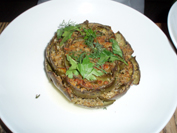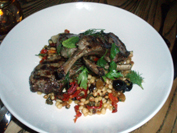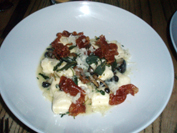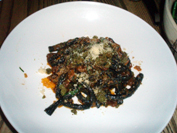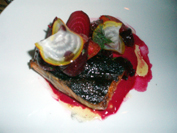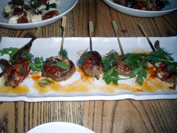Fish Tag
 Monday, December 20, 2010 at 03:21PM
Monday, December 20, 2010 at 03:21PM  The history of chef Michael Psilakis has become the culinary equivalent of “The House that Jack Built.” Every time he opens a new place, you need to tell the story of all the previous ones, to understand what is going on.
The history of chef Michael Psilakis has become the culinary equivalent of “The House that Jack Built.” Every time he opens a new place, you need to tell the story of all the previous ones, to understand what is going on.
His newest, Fish Tag, is his fourth on the same site that was once home to Onera (very good), Kefi (good), and Gus & Gabriel Gastropub (awful). He has also done five places with the restaurateur Donatella Arpaia, including Anthos (excellent, but closed), Dona (not bad; now closed), Mia Dona (where he is no longer involved), a larger version of Kefi (mediocre), and the restaurant Eos in Miami.
Where those restaurants failed, Psilakis’s cooking usually wasn’t at fault. (To go into the reasons, Jack’s House would become a whole subdivision.) Onera, Anthos, Dona, and Mia Dona, all got two stars from the Times, and Anthos should have had three. Kefi was good before it moved to a space far too large for its own good. That leaves Gus & Gabriel as Psilakis’s only outright failure (though he claims it will be reincarnated in Brooklyn), amidst a long line of successes.
At Fish Tag, the chef is once again in his sphere. It offers mainly a seafood menu—not overtly Greek, but in the same imaginative modern Greek style that was successful at Onera and Anthos. It’s more elaborate than the former, but less fancy than the latter. The layout was gutted and replaced with a sleek, elegant design that’s the best I’ve ever seen it. The dining room now seats 60 (it was formerly 75). There are now three separate bar counters that seat 30 between them.
Psilakis is hedging his bets, so Fish Tag doubles as a wine bar. To that end, many of the wines are available in three-ounce, six-ounce, or half-bottle pours, and the menu includes plenty of cheeses and cured meats for bar patrons who might not want a full meal. On the main menu, the entrées top out at $26, and there’s the ever-present $16 burger that shows up in most restaurants these days.
There are some blunders that could cost Fish Tag a whole star. After you sit down, the server utters the seven words most dreaded in the Western culinary canon: “Let me explain how our menu works.” But you really need the explanation this time. Although Fish Tag has traditional appetizers and entrées, they aren’t so stated on the menu. Instead, the items are arranged from “lightest” to “heaviest,” with appetizers in red and entrées in black.
 Groups of menu items are lassoed with large curly braces, next to which are written the spirits (wines, beers, scotches, etc.) that purportedly go with them. As if this wasn’t enough to learn, some items are marked with a “§” sign, which means (a footnote tells us) that they may be ordered “simply grilled” with potato and broccoli rabe.
Groups of menu items are lassoed with large curly braces, next to which are written the spirits (wines, beers, scotches, etc.) that purportedly go with them. As if this wasn’t enough to learn, some items are marked with a “§” sign, which means (a footnote tells us) that they may be ordered “simply grilled” with potato and broccoli rabe.
You might think this was enough complexity, but there’s more. While the wines are listed on the back of the food menu, a separate menu lists the hard liquors, ice creams, coffees, teas (“please allow five minutes for stepping”), cheeses, cured meats, and “appetizing.”
Appetizing? That’s the Jewish word for the food usually served with bagels, such as lox and other smoked fish. At our table, we received two copies of the food menu, but just one of the cheese-meat-appetizing-everything-else menu.
The good news is that once you’ve figured out how to order, Fish Tag becomes a delightful restaurant.


Young Pecorino “Saganaki,” or Sheep’s Milk Cheese ($12; above left) with lemon, garlic, and almonds, comes sizzling in a cast-iron skillet. It’s wonderful; yet, we could easily have missed it: it’s the bottom entry on the cheese menu.
Smoked Sable ($9; above right), one of ten choices from the appetizing menu, has a rich, smokey taste.


Branzino Stuffed with Head Cheese ($26; above left) is a stunning creation, and dare we say, critic bait. The menu doesn’t say whose head it’s made with (presumably lamb), but once you get past the “ick” factor it’s a brilliant dish—vintage Psilakis. Striped Bass ($23; above right), simply grilled, is a less elaborate creation, but excellent nonetheless.
 The wine list is delightful, with plenty of good buys at the $50-and-under level, my benchmark for this type of restaurant. Côtes du Roussillon Villages Latour de France is an appellation I’ve never seen before. The 2008 M. Chapoutier “Occultum Lapidem” ($45; label at right) has a light, fruity taste not unlike some Burgundies, making it a terrific red wine to go with fish. It was one of many that we could have had by the glass or the half-bottle, but we went ahead and ordered a full bottle.
The wine list is delightful, with plenty of good buys at the $50-and-under level, my benchmark for this type of restaurant. Côtes du Roussillon Villages Latour de France is an appellation I’ve never seen before. The 2008 M. Chapoutier “Occultum Lapidem” ($45; label at right) has a light, fruity taste not unlike some Burgundies, making it a terrific red wine to go with fish. It was one of many that we could have had by the glass or the half-bottle, but we went ahead and ordered a full bottle.
I photographed the label (right) after the sommelier explained that, in honor of a former blind resident of the estate, all of the wine labels from this producer are printed in braille.
At times, Fish Tag seems just a tad too precious for its own good. Tap water comes in clear glass jugs, the size of one full glass, each with its own rubber stopper, which the server removes just before setting it on the table.
But even more precious is the collection of white porcelain cake plates, which are used for serving many different items, including the smoked fish. It looks impressive, but it’s a bit awkward to eat off of an elevated pedestal.
Those idiosyncrasies aside, the service and wine program are in very good shape for a month-old restaurant. The general manager and wine director aren’t credited on the menu, nor is anyone credited at ChefDB, but whomever Psilakis hired is earning their keep. The restaurant was full, and running smoothly, at 7:00 p.m. on a Saturday evening.
Even if Fish Tag is a bit over-thought (particularly the color-coded menu), we were impressed with the food—the way we had been with Psilakis’s earlier restaurants, before he lost his way in the last couple of years. Will Psilakis stick around long enough to ensure Fish Tag remains relevant? Or will he hop to a new project after the reviews are in? Ryan Skeen is assisting in the kitchen, but no one expects that to last: it’s the serial job-hopper’s seventh restaurant in three years.
Let’s hope that Psilakis has learned his lessons well, and that he’ll make Fish Tag his main focus. This is where he belongs.
Fish Tag (222 W. 79th St. between Broadway & Amsterdam Ave., Upper West Side)
Food: **
Service: **
Ambiance: **
Overall: **




